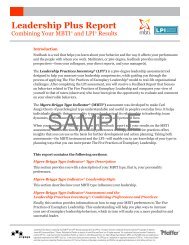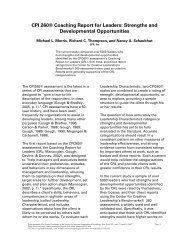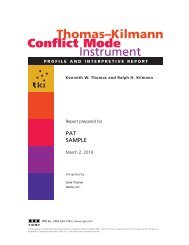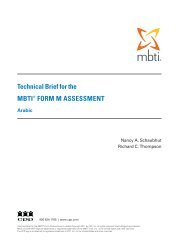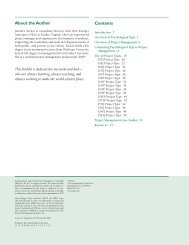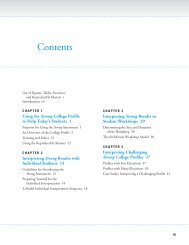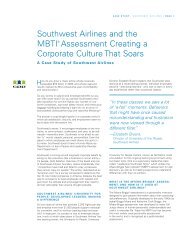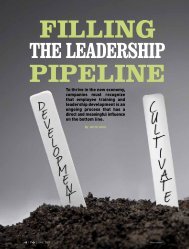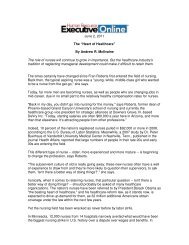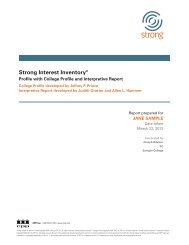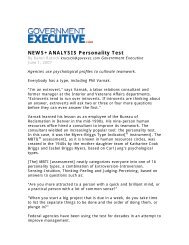workforce and succession management in a changing ... - CPP.com
workforce and succession management in a changing ... - CPP.com
workforce and succession management in a changing ... - CPP.com
- No tags were found...
You also want an ePaper? Increase the reach of your titles
YUMPU automatically turns print PDFs into web optimized ePapers that Google loves.
<strong>CPP</strong> GLOBAL HUMAN CAPITAL REPORTNOVEMBER 2008WORKFORCE ANDSUCCESSION MANAGEMENTIN A CHANGING WORLDMaximiz<strong>in</strong>g PeoplePerformance
WORKPLACE ANDSUCCESSION MANAGEMENTIN A CHANGING WORLDMaximiz<strong>in</strong>g PeoplePerformanceFOREWORD by Jeff Hayes, CEO, <strong>CPP</strong>, Inc.As the global economy cont<strong>in</strong>ues to unravel,today’s <strong>workforce</strong>s face pressures <strong>and</strong> dilemmasnot seen <strong>in</strong> decades. And while executives moveto preserve their <strong>com</strong>panies’ bottom l<strong>in</strong>es, a lessobvious (but equally critical) challenge looms that,if ignored, could have devastat<strong>in</strong>g conse quences.Organizations underst<strong>and</strong> that <strong>workforce</strong> <strong>and</strong> <strong>succession</strong> <strong>management</strong> are essential to ensure cont<strong>in</strong>u<strong>in</strong>g success.To discover what they’re do<strong>in</strong>g to ma<strong>in</strong>ta<strong>in</strong> an effective <strong>workforce</strong> <strong>and</strong> assure themselves of effectiveleadership for the future, <strong>CPP</strong> surveyed hundreds of HR professionals from around the world. The survey focusedon organizations’ current <strong>workforce</strong> <strong>and</strong> <strong>succession</strong> <strong>management</strong> challenges <strong>and</strong> practices, <strong>and</strong> expectations<strong>and</strong> preparations for <strong>workforce</strong> <strong>and</strong> <strong>succession</strong> <strong>management</strong> over the next 10 years. The results po<strong>in</strong>tto a loom<strong>in</strong>g “leadership gap” as well as a number of formidable challenges to current <strong>and</strong> future leadershipdevelopment <strong>and</strong> <strong>succession</strong> <strong>management</strong> efforts.
While a talented <strong>and</strong> focused <strong>workforce</strong> can navigate a multitude of obstacles to achieve success <strong>in</strong> the mostfiercely contested space, even a <strong>com</strong>pany with <strong>in</strong>novative products <strong>and</strong> a sound reputation may be driven tothe ground by poor leadership <strong>and</strong> an <strong>in</strong>effective employee base. <strong>CPP</strong>, therefore, <strong>com</strong>missioned this study <strong>in</strong>order to explore the steps organizations are tak<strong>in</strong>g to reta<strong>in</strong> a <strong>com</strong>petitive <strong>workforce</strong> <strong>in</strong> the <strong>com</strong><strong>in</strong>g years. Thefollow<strong>in</strong>g report summarizes the op<strong>in</strong>ions of hundreds of HR professionals <strong>and</strong> l<strong>in</strong>e-of-bus<strong>in</strong>ess managersfrom various regions worldwide (<strong>in</strong>clud<strong>in</strong>g North America, Europe, Asia-Pacific, Brazil <strong>and</strong> South Africa) ontheir preparations <strong>and</strong> projections for the <strong>com</strong><strong>in</strong>g decade, as well as their current challenges <strong>and</strong> practices.The study shows that developed 21st-century societies <strong>and</strong> economies face strik<strong>in</strong>gly similar challenges regard<strong>in</strong>g<strong>workforce</strong> <strong>and</strong> <strong>succession</strong> <strong>management</strong>. Overall, results <strong>in</strong>dicate broad awareness of the loom<strong>in</strong>g“leadership gap,” expected to fully materialize over the next decade as Generation X struggles to fill the holesleft by droves of retir<strong>in</strong>g Baby Boomers. Our f<strong>in</strong>d<strong>in</strong>gs <strong>in</strong>dicate, however, that the majority of organizations areneither prepared, nor are tak<strong>in</strong>g the necessary steps to meet this challenge head-on.While more than half of all respondents (58%) expect their organizations to grow <strong>in</strong> the near future, the majorityof respondents from all regions, with the exception of Brazil, also expect hir<strong>in</strong>g, reta<strong>in</strong><strong>in</strong>g <strong>and</strong> develop<strong>in</strong>gleaders to be<strong>com</strong>e more difficult over the next 10 years.This outlook is particularly acute <strong>in</strong> North America, where baby boomers are beg<strong>in</strong>n<strong>in</strong>g to exit the <strong>workforce</strong> enmasse. Furthermore, most respondents appear to be fully aware that their organizations will soon face the dual challengeof <strong>in</strong>creased <strong>com</strong>petition for new hires, <strong>and</strong> <strong>in</strong>creased danger of los<strong>in</strong>g valued employees to <strong>com</strong>petitors.It is both puzzl<strong>in</strong>g <strong>and</strong> troubl<strong>in</strong>g, therefore, that the study <strong>in</strong>dicates an overall lack of preparedness to meetthese challenges. Worldwide, far too few organizations have <strong>in</strong>stituted mechanisms to reta<strong>in</strong> <strong>and</strong> develop tomorrow’sleaders. No more than 40% of all respondents report hav<strong>in</strong>g a formalized <strong>succession</strong> or executivecoach<strong>in</strong>g program <strong>in</strong> place <strong>in</strong> their organization, <strong>and</strong> only slightly more than half (54%) report hav<strong>in</strong>g a process<strong>in</strong> place to identify <strong>in</strong>dividuals with high leadership potential.
4Not surpris<strong>in</strong>gly given the lack of organizational preparation, we found that the majority (60% worldwide <strong>and</strong>72% <strong>in</strong> the U.S.) of respondents are brac<strong>in</strong>g for the impact of ill-equipped employees assum<strong>in</strong>g higher-level positionsdue to the lack of available leadership talent. It is likely no co<strong>in</strong>cidence that respondents also expect theimpact from employee burnout to be high, as few factors discourage a <strong>workforce</strong> more than poor leadership.Respondents cited several challenges to their leadership development plans, <strong>in</strong>clud<strong>in</strong>g a rapidly chang<strong>in</strong>g<strong>com</strong>petitive environment, knowledge retention, pressure to <strong>in</strong>novate, generational differences, <strong>and</strong>, most notably,pressure to cut costs. While these problems will no doubt cont<strong>in</strong>ue to plague the bus<strong>in</strong>ess <strong>com</strong>munityat large, <strong>in</strong>dividual organizations are not unavoidably at the mercy of these demographic forces <strong>and</strong> the on<strong>com</strong><strong>in</strong>g“leadership gap.” <strong>CPP</strong> has consulted with <strong>com</strong>panies of all sizes <strong>and</strong> <strong>in</strong> all <strong>in</strong>dustries for more than fivedecades. <strong>CPP</strong> shares the op<strong>in</strong>ion of many of the respondents who expressed that a solid leadership developmentprogram can ensure that organizations identify, reta<strong>in</strong> <strong>and</strong> prepare their future leaders, <strong>and</strong> can reenergizeemployee bases that have lost momentum. For years, the <strong>com</strong>pany has put together programs that havehelped <strong>com</strong>panies of all sizes deal with <strong>succession</strong> <strong>management</strong> long before this leadership gap emerged.It has been said of modern government that leaders tend to focus on the “urgent” at the expense of the “important.”For bus<strong>in</strong>ess leaders, the “important” may very well be def<strong>in</strong>ed by the revitalization of its leadership pipel<strong>in</strong>es.As today’s leaders make “urgent” decisions regard<strong>in</strong>g cost-cutt<strong>in</strong>g, they must not succumb to pressureto scrimp on leadership development. Human capital – <strong>in</strong> particular, leadership ability – may turn out to be themost sought after <strong>com</strong>modity as the new century unfolds. Given this loom<strong>in</strong>g shortage, tomorrow’s leadersmust be prepared to assume more responsibility than their predecessors, while at the same time br<strong>in</strong>g<strong>in</strong>g lessexperience to the table.Leadership development is the key to surviv<strong>in</strong>g <strong>and</strong> thriv<strong>in</strong>g <strong>in</strong> the forth<strong>com</strong><strong>in</strong>g climate. It is, therefore, <strong>in</strong>cumbentupon today’s organizations to <strong>in</strong>stitute formalized <strong>succession</strong> plann<strong>in</strong>g <strong>and</strong> executive coach<strong>in</strong>g programsthat identify those with leadership potential <strong>and</strong> nurture their talent. Additionally, as it will likely be much moredifficult to procure outside talent, organizations must foster a work environment that maximizes retentionof high-value employees. Successful organizations will make tra<strong>in</strong><strong>in</strong>g a top priority, even when time <strong>and</strong> resourcesare scarce.EXECUTIVE SUMMARYOrganizations underst<strong>and</strong> that <strong>workforce</strong> <strong>and</strong> <strong>succession</strong> <strong>management</strong> are essential to ensure cont<strong>in</strong>u<strong>in</strong>g success.To discover what they’re do<strong>in</strong>g to ma<strong>in</strong>ta<strong>in</strong> an effective <strong>workforce</strong> <strong>and</strong> assure themselves of effectiveleadership for the future, <strong>CPP</strong> surveyed hundreds of HR professionals from around the world. The survey focusedon organizations’ current <strong>workforce</strong> <strong>and</strong> <strong>succession</strong> <strong>management</strong> challenges <strong>and</strong> practices, <strong>and</strong> expectations<strong>and</strong> preparations for <strong>workforce</strong> <strong>and</strong> <strong>succession</strong> <strong>management</strong> over the next 10 years. The results po<strong>in</strong>tto a loom<strong>in</strong>g “leadership gap” as well as a number of formidable challenges to current <strong>and</strong> future leadershipdevelopment <strong>and</strong> <strong>succession</strong> <strong>management</strong> efforts.
5INTRODUCTIONFROM EXPECTATIONS TO PREPARATIONSPlann<strong>in</strong>g, by def<strong>in</strong>ition, is a matter of anticipat<strong>in</strong>g the future. Successful plann<strong>in</strong>g—sett<strong>in</strong>g yourself up notjust to survive but to thrive—is a two-step process. First, you must def<strong>in</strong>e what you expect will happen <strong>in</strong> thefuture, giv<strong>in</strong>g careful attention to anticipated changes <strong>and</strong> challenges that are different <strong>in</strong> k<strong>in</strong>d or degree fromthose you face today. Then you must formulate <strong>and</strong> implement a plan of action that will prepare you for thefuture you envision, especially the changes <strong>and</strong> new challenges.This study of <strong>workforce</strong> <strong>and</strong> <strong>succession</strong> <strong>management</strong> is based on such a view of successful plann<strong>in</strong>g. BetweenNovember 2007 <strong>and</strong> January 2008, <strong>CPP</strong>, Inc., surveyed HR professionals <strong>and</strong> l<strong>in</strong>e-of-bus<strong>in</strong>ess managers fromvarious regions of the world on their current <strong>workforce</strong> <strong>and</strong> <strong>succession</strong> <strong>management</strong> challenges <strong>and</strong> practices<strong>and</strong> their preparations <strong>and</strong> projections for the <strong>com</strong><strong>in</strong>g decade. (Appendix 1 provides a <strong>com</strong>plete description ofthe survey’s scope <strong>and</strong> methodology.)Statistically, the responses revealed both variations <strong>and</strong> patterns. No doubt the variations reflect demographic<strong>and</strong> developmental differences among the regions represented—<strong>com</strong>plex issues that are beyond the scopeof this study. The patterns, however, show that the challenges of <strong>workforce</strong> <strong>and</strong> <strong>succession</strong> <strong>management</strong> aresimilar, if not universal, across developed 21st-century societies <strong>and</strong> economies.IN THEIROWNWORDSNumbers rarely if ever tell the whole story. That’s why surveyparticipants were encouraged to <strong>com</strong>ment on the issues, challenges,<strong>and</strong> practices of <strong>workforce</strong> <strong>and</strong> <strong>succession</strong> <strong>management</strong>.Excerpts from those “<strong>in</strong> their own words” <strong>com</strong>ments arepresented <strong>in</strong> sidebars like this one throughout this report—rem<strong>in</strong>ders that <strong>workforce</strong>s are made up of people <strong>and</strong> that<strong>workforce</strong> <strong>and</strong> <strong>succession</strong> <strong>management</strong> is a matter of humanas well as organizational development.
6THE BIG PICTURE: HEAD COUNTNOW AND THENMore than half (58%) of the survey respondents expectedtheir organization to grow, <strong>in</strong> terms of numberof employees, over the next 10 years. One <strong>in</strong> four (25%)expected their head count to stay the same, <strong>and</strong> 17%expected it to decrease. Regionally, Asia Pacific <strong>and</strong> Brazilhad the highest percentage of respondents (72% ofrespondents from both regions) predict<strong>in</strong>g an <strong>in</strong>crease<strong>in</strong> headcount, while Europe had the highest percentage(26%) predict<strong>in</strong>g a decl<strong>in</strong>e.Number of employees over thenext 10 years is expected to:Overall17%25%58%THE RETIREMENT WILD CARDSurvey results showed that retirement rate projectionsvary considerably from region to region—surely a reflectionof disparate regional demographic trends suchas population bulges, life span averages, health care quality<strong>and</strong> availability, sav<strong>in</strong>gs rates <strong>and</strong> social “safety nets,” <strong>and</strong>so forth.In North America, where the “baby boom” is matur<strong>in</strong>g<strong>in</strong>exorably <strong>in</strong>to a “silver tsunami,” nearly 71% of respondentssaid they expect employee retirement levels to riseover the next 10 years—<strong>com</strong>pared with 43% of respondentssurveywide. In stark contrast, a mere 14% of respondents<strong>in</strong> the Asia Pacific region forecast a rise <strong>in</strong> retirementlevels. In fact, 38% of Asia Pacific respondentsbelieved that employee retirement rates will shr<strong>in</strong>k overthe next 10 years. In all other regions, nearly half of respondentsexpected retirement levels to rema<strong>in</strong> steady.North America31%11%Europe30%27%Asia Pacific19%9%Brazil16%11%43%58%72%73%IN THEIROWNWORDS“Many organizations cont<strong>in</strong>ue to ignore the needfor organizational <strong>and</strong> leadership development.Unfortunately, dur<strong>in</strong>g the time it takes to transitionout the ‘old guard,’ <strong>in</strong>novative organizationsare steal<strong>in</strong>g the younger talent. It is time even thesmall bus<strong>in</strong>ess became more aware of the successesenjoyed by organizations that recognizethe need to ‘grow’ talent <strong>and</strong> best practices.”South Africa13%24%63%IncreaseStay the SameDecrease
7THE HIRING ENVIRONMENTSurvey results revealed a hir<strong>in</strong>g environment that variesfrom region to region <strong>and</strong> across skill levels. In general,respondents reported that it’s more difficult to hire, develop,<strong>and</strong> reta<strong>in</strong> workers for higher-level positions thanfor lower-level <strong>and</strong> unskilled positions. Compared toother regions, however, Europe appears to have a moderatelyeasier time hir<strong>in</strong>g, develop<strong>in</strong>g, <strong>and</strong> reta<strong>in</strong><strong>in</strong>g higher-levelpeople today, <strong>and</strong> respondents there predictedless difficulty <strong>in</strong> do<strong>in</strong>g so over the next 10 years th<strong>and</strong>id respondents <strong>in</strong> other areas. At the other end of therange, South African respondents reported <strong>com</strong>parativelymore difficulty hir<strong>in</strong>g, develop<strong>in</strong>g, <strong>and</strong> reta<strong>in</strong><strong>in</strong>g leaderstoday, <strong>and</strong> they expected that difficulty to <strong>in</strong>crease <strong>in</strong> thenext decade.Follow<strong>in</strong>g are some of the patterns that emerged regard<strong>in</strong>gthe hir<strong>in</strong>g environment for various skill levels<strong>and</strong> positions.Skilled versus unskilled workers. At least 48% of respondents<strong>in</strong> each region (<strong>and</strong> 57% overall) th<strong>in</strong>k it issomewhat or very easy to fill unskilled positions today.Over the next 10 years, there is substantial regionalvariation on the question of whether it will get easier ormore difficult. Only 18% of North American respondentsth<strong>in</strong>k it will get easier but 46% of Asia Pacific <strong>and</strong> 50% ofBrazilian respondents believe it will get easier.The outlook for skilled labor is different. Regard<strong>in</strong>g fill<strong>in</strong>gskilled positions, 44% of respondents reported thatit is currently very or somewhat difficult; 30% said it isvery or somewhat easy; <strong>and</strong> 26% said it is neither onenor the other. In forecast<strong>in</strong>g the next 10 years, 38%said it will be more difficult to fill such positions, 25%said it will be much or somewhat easier <strong>and</strong> 37% took aneutral position.Fill<strong>in</strong>g sales <strong>and</strong> market<strong>in</strong>g positions. The survey respondentswere evenly split when it came to fill<strong>in</strong>g sales<strong>and</strong> market<strong>in</strong>g positions today versus over the next decade.Roughly one <strong>in</strong> four (27%) said that it’s very orsomewhat difficult to fill these positions today; about thesame proportion (26%) felt that it will be very or somewhatmore difficult <strong>in</strong> the next 10 years. In North Americawe see the biggest forecast change <strong>in</strong> this environment.29% of respondents said that hir<strong>in</strong>g sales <strong>and</strong> market<strong>in</strong>gpositions today is very or somewhat difficult. 10%more respondents (39%) suggested that it will be veryor somewhat more difficult to fill sales <strong>and</strong> market<strong>in</strong>gpositions <strong>in</strong> the next 10 years.Hir<strong>in</strong>g top executives. Just over half of all survey respondents(52%) reported that it is currently very orsomewhat difficult to fill top executive positions, <strong>and</strong>over the next 10 years, 47% expect it will be much orsomewhat more difficult. The starkest contrast betweennow <strong>and</strong> then emerged <strong>in</strong> South Africa. 76% of respondents<strong>in</strong> this region th<strong>in</strong>k it is difficult to hire top executivestoday <strong>and</strong> 34% report it will be somewhat or muchmore difficult over the next 10 years.LEADERSHIP: THE KEYSTONE OFSUCCESSION MANAGEMENTAs successful organizations recognize, leaders areneeded at—<strong>and</strong> can <strong>com</strong>e from—every level of a<strong>com</strong>pany. Good leaders are a scarce <strong>com</strong>modity <strong>and</strong>thus often are the subject of <strong>com</strong>petitive bidd<strong>in</strong>g frommultiple organizations. In other words, they are notalways readily available for hire. Therefore, leaders notonly can be but must be developed from with<strong>in</strong>. Andretention rema<strong>in</strong>s an ongo<strong>in</strong>g challenge.That’s why, <strong>in</strong> addition to ask<strong>in</strong>g respondents about thehir<strong>in</strong>g environment for top executives, the survey askedfor their assessment of the current <strong>and</strong> future environmentfor hir<strong>in</strong>g, reta<strong>in</strong><strong>in</strong>g, <strong>and</strong> develop<strong>in</strong>g good leaders.Hir<strong>in</strong>g good leaders. Survey results <strong>in</strong>dicated that it’snot easy to f<strong>in</strong>d good leaders <strong>and</strong> it’s not expected to getany easier. A solid majority of respondents worldwide(63%) reported that it is very or somewhat difficult tohire good leaders today. And over the next decade, 49%of all respondents said, hir<strong>in</strong>g good leaders will be moredifficult than it already is.Respondents <strong>in</strong> South Africa <strong>and</strong> Brazil reported thegreatest difficulty hir<strong>in</strong>g good leaders today (83% <strong>and</strong>77%, respectively), <strong>and</strong> prospects appear to be especiallygrim <strong>in</strong> South Africa, where 76% of respondents said itwill be<strong>com</strong>e even more difficult over the next 10 years.<strong>CPP</strong> GLOBAL HUMAN CAPITAL REPORT
8In detail, the results were as follows:Today, how easy or difficult is it to hire good leaders?Overall12%63%North America13%70%Over the next ten years, will it be easieror more difficult to hire good leaders?OverallNorth America6%17%49%68%Europe19%48%Europe14%37%Asia Pacific8%71%Asia Pacific22%54%Brazil5%77%Brazil28%44%South AfricaSouth Africa4%83%13%76%Very or somewhat easyVery or somewhat difficultMuch or somewhat easierMuch more or somewhat more difficultNote: a middle “neutral” option wasoffered to respondents; however,the “neutral” responses are notrepresented <strong>in</strong> these tablesReta<strong>in</strong><strong>in</strong>g good leaders. When it’s difficult to hire good leaders, it’s all the more important that organizations hold onto the ones they have. But that’s no easy task, accord<strong>in</strong>g to the survey results, <strong>and</strong> it’s likely to be<strong>com</strong>e more difficultover the next 10 years. Today, 46% of all respondents reported, it’s very or somewhat difficult to reta<strong>in</strong> good leaders.Only 25% said it’s very or somewhat easy. And 48% expect it to be more difficult to reta<strong>in</strong> good leaders over the next10 years than it is today, while just 17% th<strong>in</strong>k it will be easier.Respondents <strong>in</strong> North America highlighted the trend of difficulty with employee retention. Of that group, 39% said it isvery or somewhat easy to reta<strong>in</strong> good leaders today—the highest percentage <strong>in</strong> this category among all regions. But68% predicted that it will be more difficult over the next 10 years than it is today—a rate of skepticism second only tothat of South African respondents (71%).
9In detail, the results were as follows:Today, how easy or difficult isit to reta<strong>in</strong> good leaders?OverallNorth AmericaEurope25%25%39%37%37%46%In detail, the results were as follows:Over the next 10 years, will it be easieror more difficult to reta<strong>in</strong> good leaders?OverallNorth America10%17%Europe12%34%48%68%<strong>CPP</strong> GLOBAL HUMAN CAPITAL REPORTAsia PacificAsia Pacific16%56%21%55%BrazilBrazil28%52%30%42%South Africa20%65%South Africa13%71%Very or somewhat easyVery or somewhat difficultMuch or somewhat easierMuch more or somewhat more difficultNote: a middle “neutral” option wasoffered to respondents; however,the “neutral” responses are notrepresented <strong>in</strong> these tablesDevelop<strong>in</strong>g good leaders. When both hir<strong>in</strong>g <strong>and</strong> reta<strong>in</strong><strong>in</strong>g good leaders is difficult <strong>and</strong> likely to be<strong>com</strong>e more so overtime, as survey respondents predicted, the pressure grows for organizations to develop their own leaders. But the datasuggest that this, too, is a daunt<strong>in</strong>g task. Just over half of all respondents (53%) reported that it’s very or somewhatdifficult to develop good leaders today, <strong>and</strong> only 25% predicted that the task will be<strong>com</strong>e easier over the next decade.Respondents <strong>in</strong> South Africa <strong>and</strong> Brazil reported the greatest difficulty develop<strong>in</strong>g good leaders today (74% <strong>and</strong> 67%,respectively). However, respondents <strong>in</strong> Brazil were more sangu<strong>in</strong>e about the future, with 46% predict<strong>in</strong>g that it will bemuch or somewhat easier to develop good leaders over the next decade. Indeed, Brazil is the only region <strong>in</strong> which respondentsexpect<strong>in</strong>g leadership development to be<strong>com</strong>e easier outnumbered those who anticipated it be<strong>com</strong><strong>in</strong>g moredifficult. In contrast, nearly 60% of South African respondents projected that develop<strong>in</strong>g good leaders will be muchmore or somewhat more difficult go<strong>in</strong>g forward.
11IN THEIROWNWORDS“We are us<strong>in</strong>g leadership <strong>com</strong>petencies <strong>and</strong> core <strong>com</strong>petencies as amethod of benchmark<strong>in</strong>g our current talent aga<strong>in</strong>st our future needs.We are work<strong>in</strong>g to create <strong>in</strong>dividual development plans that help to closethe gaps <strong>in</strong> <strong>com</strong>petencies, coupled with a strengths-based approachthat focuses on unleash<strong>in</strong>g the potential with<strong>in</strong> every employee.”Percentage of respondents report<strong>in</strong>g that their organization has a formal leadership development program100%90%80%70%60%50%40%30%20%10%0%OverallNorthAmericaEuropeAsiaPacificBrazilSouthAfrica<strong>CPP</strong> GLOBAL HUMAN CAPITAL REPORTEven fewer—just 38% of all respondents—reported hav<strong>in</strong>g a formalized <strong>succession</strong> plan <strong>in</strong> place <strong>in</strong> their organization.Interest<strong>in</strong>gly, <strong>com</strong>panies <strong>in</strong> Europe (43%) <strong>and</strong> Asia Pacific (42%) seem to be ahead of the curve: Higher percentagesof respondents <strong>in</strong> those regions claimed to have such a plan <strong>in</strong> place. But <strong>in</strong> no region did more than 43% ofrespondents <strong>in</strong>dicate that their organization is engaged <strong>in</strong> formalized <strong>succession</strong> plann<strong>in</strong>g.Percentage of respondents report<strong>in</strong>g that their organization has a formalized <strong>succession</strong> plan100%90%80%70%60%50%40%30%20%10%0%OverallNorthAmericaEuropeAsiaPacificBrazilSouthAfricaIN THEIROWNWORDS“The focus for us needs to be on more formal employee developmentprograms (<strong>in</strong>clud<strong>in</strong>g <strong>management</strong> <strong>and</strong> senior leaders) to support thecurrent organization <strong>and</strong> expected growth over the next five to 10 years.This will <strong>in</strong>clude <strong>in</strong>dividual career development programs, <strong>succession</strong>plann<strong>in</strong>g, <strong>and</strong> mentor<strong>in</strong>g, to pass on <strong>and</strong> reta<strong>in</strong> <strong>com</strong>pany, <strong>in</strong>dustry, <strong>and</strong>functional knowledge.”
12EMPLOYEE DEVELOPMENT PRACTICESTo ascerta<strong>in</strong> how organizations are go<strong>in</strong>g about the task of develop<strong>in</strong>g leaders <strong>and</strong> other employees, the surveyfocused on three primary tools that organizations <strong>com</strong>monly use: 360° assessments, personality assessments, <strong>and</strong>executive coach<strong>in</strong>g. The responses revealed some <strong>in</strong>terest<strong>in</strong>g regional variation <strong>in</strong> the popularity of these practices.360° assessments. The use of 360° assessments for employee <strong>and</strong> leadership development ranked lowest of thethree tools. Overall, only 38% of respondents reported that their organization uses 360° assessments. In NorthAmerica, the percentage was higher, with just over half (51%) of respondents <strong>in</strong>dicat<strong>in</strong>g that their organization usesthis development tool. European respondents reported the lowest rate of use, at only 28%.Percentage of respondents <strong>in</strong>dicat<strong>in</strong>g their organization uses 360° assessments100%90%80%70%60%50%40%30%20%10%0%OverallNorthAmericaEuropeAsiaPacificBrazilSouthAfricaPersonality assessments. Personality assessments are used for both employee selection <strong>and</strong> employee development.Overall, 56% of respondents <strong>in</strong>dicated that their <strong>com</strong>pany currently uses these tools. Respondents <strong>in</strong> SouthAfrica <strong>and</strong> Brazil <strong>in</strong>dicated the highest usage—76% <strong>and</strong> 70%, respectively.Percentage of respondents <strong>in</strong>dicat<strong>in</strong>g their organization uses personality assessments100%90%80%70%60%50%40%30%20%10%0%OverallNorthAmericaEuropeAsiaPacificBrazilSouthAfricaIN THEIROWNWORDS“The most successful <strong>com</strong>panies do not employ leadership tra<strong>in</strong><strong>in</strong>g asa one-off session. They cont<strong>in</strong>ually develop <strong>and</strong> cont<strong>in</strong>ually tra<strong>in</strong>, evenwhen time is precious <strong>and</strong> tra<strong>in</strong><strong>in</strong>g time nonexistent. It takes precedence,<strong>and</strong> is implemented.”
14Nearly as many respondents—43%—cited pressure tocut costs as a very serious challenge to their leadershipdevelopment plans. With another 44% of all respondentsnot<strong>in</strong>g this pressure as a somewhat serious challenge,fully 87% of respondents’ leadership development plansappear to be vulnerable to f<strong>in</strong>ancial constra<strong>in</strong>ts. AmongNorth American respondents, 91% believed that this challengeis somewhat or very serious <strong>and</strong> <strong>in</strong> South Africa,94% of respondents are feel<strong>in</strong>g this pressure acutely.IN THEIROWNWORDS“While some leadership <strong>com</strong>petencies areuniversal, others change due to the dynamicsof the environment. It takes strong leadershipto beget strong leadership.”Number of employees over the next10 years is expected to:Overall13%North America9%Europe17%Asia Pacific16%Brazil10%South Africa7%41%38%37%38%44%43%45%43%50%47%52%50%Not at all seriousSomewhat seriousVery seriousOverall, 86% of respondents rated knowledge retentionas a very or somewhat serious challenge to their organization’sleadership development plan. This answer wasselected by more than 90% of respondents from NorthAmerica, Brazil, <strong>and</strong> South Africa. These three regionsalso had the highest percentage of respondents report<strong>in</strong>gthat the large numbers of workers retir<strong>in</strong>g is a veryor somewhat serious challenge. At the same time, Brazil<strong>and</strong> South Africa had the highest percentage of respondents<strong>in</strong>dicat<strong>in</strong>g that global <strong>com</strong>petition for leadershiptalent is a very or somewhat serious challenge. With somany workers—<strong>and</strong> leaders—retir<strong>in</strong>g or leav<strong>in</strong>g theirpositions for other opportunities brought about by theheated <strong>com</strong>petition for talent, it’s hardly surpris<strong>in</strong>g thatorganizations are concerned about how best to reta<strong>in</strong> thebase of knowledge that resides with their <strong>workforce</strong>.
15Overall14%IN THEIROWNWORDS“Companies must <strong>in</strong>vest <strong>in</strong> the future—not only<strong>in</strong> products <strong>and</strong> equipment, but <strong>in</strong> people. Thisis not a priority for most <strong>com</strong>panies, as the ever<strong>com</strong>petitive marketplace reduces staff tra<strong>in</strong><strong>in</strong>gto a very low priority (if it is a priority at all).”Level of seriousness that the rapidly chang<strong>in</strong>g<strong>com</strong>petitive environment has on leadershipdevelopment plans:North America9%Europe26%Asia Pacific10%Brazil6%23%32%South Africa2%37%39%43%43%45%45%54%51%Not at all seriousSomewhat seriousVery serious59%62%Level of seriousness that large numbers of workersretir<strong>in</strong>g has on development plans:OverallNorth America29%Europe17%Asia PacificBrazil36%South Africa39%13%20%15%33%32%44%41%42%42%43%44%48%47%24%Not at all seriousSomewhat seriousVery seriousIN THEIROWNWORDS“Reta<strong>in</strong><strong>in</strong>g talent, knowledge, <strong>and</strong> experience iskey to a bus<strong>in</strong>ess. All too often we want ‘newblood’ <strong>and</strong> we overlook who we have. Well, allwe’re do<strong>in</strong>g when we get ‘new blood’ is pay<strong>in</strong>ga premium for some other bus<strong>in</strong>ess’s ‘oldblood!’ The challenge is to keep people excitedabout where they are currently work<strong>in</strong>g, <strong>and</strong> developmentprograms are key.”<strong>CPP</strong> GLOBAL HUMAN CAPITAL REPORT
16Level of seriousness that the global<strong>com</strong>petition for leadership talent hason leadership development plans:OverallNorth AmericaEuropeAsia Pacific13%Brazil9%22%25%South Africa9%19%34%33%35%36%43%43%41%46%41%46%50%Not at all seriousSomewhat seriousVery serious55%Level of seriousness that pressure to <strong>in</strong>novatehas on leadership development plans:OverallNorth America7%15%EuropeAsia Pacific9%Brazil15%26%South Africa6%29%32%40%35%44%41%45%45%49%51%Not at all seriousSomewhat seriousVery serious53%59%Pressure to <strong>in</strong>novate is another widely felt challenge, with 85% of respondents call<strong>in</strong>g it very or somewhat serious. Atthe extremes were Brazil <strong>and</strong> South Africa, with more than half of respondents cit<strong>in</strong>g pressure to <strong>in</strong>novate as a veryserious challenge, <strong>and</strong> Europe, with only 29% cit<strong>in</strong>g it as such. Meanwhile, Asia Pacific faces a triple threat. Fully 91%of respondents there cited the pressure to <strong>in</strong>novate, 93% cited br<strong>in</strong>g<strong>in</strong>g new products <strong>and</strong> services to market, <strong>and</strong> 88%cited expansion <strong>in</strong>to new markets as somewhat or very serious challenges.
17Level of seriousness that br<strong>in</strong>g<strong>in</strong>g newproducts & services to market has onleadership development plans:OverallNorth AmericaEurope25%27%34%32%34%34%33%42%40%Level of seriousness that expansion<strong>in</strong>to new markets has on leadershipdevelopment plans:OverallNorth AmericaEurope22%26%32%31%35%35%35%42%43%<strong>CPP</strong> GLOBAL HUMAN CAPITAL REPORTAsia PacificAsia Pacific8%44%48%12%44%44%BrazilBrazil22%31%47%20%31%49%South AfricaSouth Africa18%38%44%22%43%35%Not at all seriousSomewhat seriousVery seriousNot at all seriousSomewhat seriousVery seriousAlso considered a serious challenge is the shortage of available skilled or educated workers. Overall, 83% of respondentsranked this shortage as a somewhat or very serious challenge to leadership development plans. In Brazil <strong>and</strong>South Africa, 63% <strong>and</strong> 72%, respectively, ranked it as a very serious challenge. It appears to be of far less concern,though still reported, <strong>in</strong> Europe: 25% of respondents there reported that the shortage of skilled or educated workers isnot at all serious.
18Level of seriousness that expansion<strong>in</strong>to new markets has on leadershipdevelopment plans:Overall17%North America16%Europe25%Asia Pacific16%Brazil8%26%29%South Africa2%26%35%32%39%44%49%49%52%Not at all seriousSomewhat seriousVery serious63%72%Respondents were also asked about generational differenceswith<strong>in</strong> the <strong>workforce</strong>. Given how much coveragethis issue has received <strong>in</strong> the North American human resource<strong>com</strong>munity, it’s not surpris<strong>in</strong>g that it is felt mostacutely <strong>in</strong> that region: 86% of respondents there reportedthat generational differences pose a very or somewhatserious challenge to leadership development plans. Brazilcame a close second <strong>in</strong> concern about this issue, with82% of respondents identify<strong>in</strong>g it as a challenge.OverallIN THEIROWNWORDS“[You have to be] will<strong>in</strong>g to view the up<strong>com</strong><strong>in</strong>g<strong>workforce</strong> as what they are, different from thepeople you hired on with.”Level of seriousness that generationaldifferences with<strong>in</strong> the <strong>workforce</strong> haveon leadership development plans:North America14%Europe23%Asia Pacific21%Brazil18%26%27%27%29%30%South Africa20%40%37%33%48%50%48%52%Not at all seriousSomewhat seriousVery serious59%
19IN THEIROWNWORDS“Identify<strong>in</strong>g <strong>and</strong> mentor<strong>in</strong>g of younger <strong>and</strong> neweremployees by seasoned employees is the key.”IMPACT OF CHALLENGES TOLEADERSHIP DEVELOPMENTRespondents were also asked how they thought the challengesto their leadership development efforts might affecttheir organization. The results varied by region.Overall, respondents <strong>in</strong>dicated that the greatest impactwill result from unprepared employees assum<strong>in</strong>g higherlevelpositions due to the lack of available talent. Thesecond greatest impact expected is employee burnout,which is hardly surpris<strong>in</strong>g. As they expect ongo<strong>in</strong>g challengesfrom a <strong>com</strong>petitive environment, pressures tocut costs, the need to <strong>in</strong>novate, <strong>and</strong> a shortage of skilledworkers, how can organizations not be concerned thattheir <strong>workforce</strong>s may suffer from burnout?Level of seriousness that expansion<strong>in</strong>to new markets has on leadershipdevelopment plans:Overall4%North America3%Europe5%Asia Pacific2%Brazil8%South Africa0%28%28%38%36%38%35%33%48%42%43%40%45%43%57%54%50%48%55%53%60%72%77%76%87%<strong>CPP</strong> GLOBAL HUMAN CAPITAL REPORTLoss or decrease of ability to <strong>in</strong>novateEmployee burnoutUnprepared people assum<strong>in</strong>g higher level ofpositions due to lack of available talentLoss of bus<strong>in</strong>ess/market share/revenueOther
20PREPAREDNESS FOR FACING ACHANGING WORLDDespite the many <strong>workforce</strong> changes <strong>and</strong> challengesthey foresee, the majority of respondents stated thattheir organization is very or somewhat well prepared todevelop leaders over the next 10 years. South Africa hadthe brightest outlook, with nearly 40% of respondentsreport<strong>in</strong>g that their organization is very well prepared.Europe ranked second <strong>in</strong> this category, with 27% report<strong>in</strong>gbe<strong>in</strong>g very well prepared, followed by Asia <strong>and</strong> Brazil,both at 24%. North American respondents appear to bethe least optimistic, with only 18% report<strong>in</strong>g their organizationis very well prepared to develop the leaders itwill need over the next 10 years.KEY RESULTS AND CONCLUSIONSAltogether, the results of <strong>CPP</strong>’s <strong>workforce</strong> <strong>and</strong> <strong>succession</strong><strong>management</strong> survey validate the existence of aloom<strong>in</strong>g “leadership gap” found <strong>in</strong> many other researchf<strong>in</strong>d<strong>in</strong>gs. What this survey found <strong>in</strong> particular, is that thelevel of plann<strong>in</strong>g <strong>and</strong> preparation required to mitigate theimpact of this gap is not as far advanced as one wouldth<strong>in</strong>k or hope.There’s no question that organizations are scann<strong>in</strong>g theirown ranks for the leaders of the future, but proactiveefforts to develop those leaders lag. Nearly 70% of respondentssay their organizations actively work to def<strong>in</strong>ethe <strong>com</strong>petencies they need <strong>in</strong> leaders. Only slightlymore than half, however, have a process <strong>in</strong> place eitherto identify employees with leadership potential or to developthat potential. And even fewer—slightly more thanone third—report hav<strong>in</strong>g any k<strong>in</strong>d of formal <strong>succession</strong>plann<strong>in</strong>g <strong>in</strong> place.The challenges are many <strong>and</strong> widespread. For example,well over 80% of respondents report that a chang<strong>in</strong>g<strong>com</strong>petitive environment <strong>and</strong> pressure to cut costsare serious challenges to their leadership developmentplans. But, given the loom<strong>in</strong>g shortage of good leaders,it’s clear that formalized <strong>succession</strong> plann<strong>in</strong>g is a mustfor organizations that want to thrive <strong>in</strong> the years ahead.And without leadership development programs <strong>in</strong> placeto develop those who will succeed exit<strong>in</strong>g leaders, it’sdifficult to formalize <strong>succession</strong> plann<strong>in</strong>g.The leadership gap, widely expected to grow <strong>in</strong> the nearfuture, will surely test the resources <strong>and</strong> resolve of organizations<strong>in</strong>tent on success. And what many may needmore than anyth<strong>in</strong>g else is an accurate assessment oftheir leadership development needs <strong>and</strong> a practical <strong>succession</strong>plan for meet<strong>in</strong>g those needs.IN THEIROWNWORDS“Leadership development cannot be overemphasized.Noth<strong>in</strong>g is more dishearten<strong>in</strong>g to employeesthan to have <strong>in</strong>effective, unprepared, orknowledge-poor leadership. [But] a solid leadershipdevelopment program can reenergize evensome of the most jaded middle- to upper-<strong>management</strong>types. It builds self-esteem <strong>and</strong> confidence<strong>and</strong> gives a def<strong>in</strong>ite return on <strong>in</strong>vestment.”APPENDIX 1: METHODOLOGYThe data for this analysis were gathered between November2007 <strong>and</strong> January 2008 via an onl<strong>in</strong>e survey<strong>com</strong>pleted by 636 HR professionals <strong>in</strong> North America,Europe, Asia Pacific, Brazil, <strong>and</strong> South Africa. Invitationsto participate were issued via e-mail <strong>and</strong> the survey waslive for 75 days.Respondents were drawn from a wide range of <strong>in</strong>dustries,<strong>in</strong>clud<strong>in</strong>g manufactur<strong>in</strong>g, retail, f<strong>in</strong>ance, transportation,professional services, <strong>and</strong> others.The respondents’ self-described “demographics” with<strong>in</strong>their organizations were as follows:In light of all the other results, perhaps the most surpris<strong>in</strong>gf<strong>in</strong>d<strong>in</strong>g of the survey is this: The majority of respondentsworldwide believe their organizations are wellprepared to develop leaders over the next 10 years.
21Organizational Level of Respondents26%17%6%6%ExecutiveEntry LevelTop ExecutiveNon-supervisory EmployeeSupervisorManagement<strong>CPP</strong> GLOBAL HUMAN CAPITAL REPORT20%27%Functional Area of Respondents12%27%6%Benefits/InsuranceCompensation/PayrollGlobal HR/Relocation3%1%2%HR Information SystemsHuman Resources/Personnel ManagementLabor/Industrial/Employee RelationsOrganizational Development5%Recruitment/Employment/Staff<strong>in</strong>gTra<strong>in</strong><strong>in</strong>g/Development/Education22%Other16%6%
22Industry of Respondents1% 2% 2%32%11%Agriculture, forestry, & fish<strong>in</strong>gM<strong>in</strong><strong>in</strong>g1%4%ConstructionManufactur<strong>in</strong>gWholesale tradeRetail Trade8%F<strong>in</strong>ance, <strong>in</strong>surance, & real estateProfessional, scientific, & technical servicesPersonal care & other services5%13%Transportation, electric, gas, & sanitary servicesInformation systems & technology5%Information, media, & <strong>com</strong>munications8%9%Other® MBTI, Myers-Briggs Type Indicator, Myers-Briggs <strong>and</strong> the MBTI logo are registered trademarks of the MBTI, Trust Inc.® FIRO-B, the FIRO-B logo, <strong>and</strong> CPI 260 are registered trademarks of <strong>CPP</strong>, Inc.® California Psychological Inventory, CPI, <strong>and</strong> Strong Interest Inventory are trademarks or registered trademarks of <strong>CPP</strong>, Inc. <strong>in</strong> the UnitedStates <strong>and</strong> other countries.® The <strong>CPP</strong> logo is a registered trademark of <strong>CPP</strong>, Inc. The TKI logo is a trademark of <strong>CPP</strong>, Inc.© Copyright <strong>CPP</strong>, Inc., 2008
23WHO’S PREPARING FOR THE LEADERSHIP GAP?Company: SonyAssessment: MBTI ® InstrumentSony has greatly revised its system of human resource cultivation s<strong>in</strong>ce 2003 <strong>and</strong> has developed <strong>in</strong>dividual programs<strong>in</strong> each bus<strong>in</strong>ess sector <strong>in</strong> accordance with the environment, as well as a system of cultivation for each employee level.Sony’s experience has shown that if feedback is properly provided <strong>and</strong> type concepts— <strong>in</strong>clud<strong>in</strong>g type dynamics <strong>and</strong>development—are thoroughly expla<strong>in</strong>ed by a type expert, it is possible for employees to reta<strong>in</strong> the knowledge <strong>and</strong> evenexpect to develop new awareness as time passes.Read the Case Study by visit<strong>in</strong>g: http://www.cpp.<strong>com</strong>/SonyCompany: US MilitaryAssessment: CPI 260 ® Instrument<strong>CPP</strong> GLOBAL HUMAN CAPITAL REPORTFor more than three years, <strong>and</strong> with hundreds of military officers <strong>and</strong> civilian workers alike, the CPI 260 assessmenthas proven to be a powerful tool for creat<strong>in</strong>g a precise portrait of an <strong>in</strong>dividual’s leadership potential <strong>and</strong> for help<strong>in</strong>g thistra<strong>in</strong><strong>in</strong>g unit craft a highly effective learn<strong>in</strong>g experience for its future senior leaders.Read the Case Study by visit<strong>in</strong>g: http://www.cpp.<strong>com</strong>/MilitaryWould you like your leaders to thrive <strong>in</strong> spite of the current economic <strong>in</strong>stability?Visit www.cpp.<strong>com</strong>, or call 800.624.1765 to learn more.
Maximiz<strong>in</strong>g PeoplePerformanceS<strong>in</strong>ce its found<strong>in</strong>g <strong>in</strong> 1956, <strong>CPP</strong>, Inc., has been a lead<strong>in</strong>g publisher <strong>and</strong> providerof <strong>in</strong>novative products <strong>and</strong> services for <strong>in</strong>dividual <strong>and</strong> organizationaldevelopment, supply<strong>in</strong>g reliable tra<strong>in</strong><strong>in</strong>g solutions to bus<strong>in</strong>esses of all sizes,<strong>in</strong>clud<strong>in</strong>g the Fortune 500. The <strong>com</strong>pany’s hundreds of offer<strong>in</strong>gs have beenused by millions of <strong>in</strong>dividuals <strong>in</strong> more than 100 countries, <strong>in</strong> more than 20languages, to help people <strong>and</strong> organizations grow <strong>and</strong> develop by improv<strong>in</strong>gperformance <strong>and</strong> <strong>in</strong>creas<strong>in</strong>g underst<strong>and</strong><strong>in</strong>g.Among <strong>CPP</strong>’s world-renowned br<strong>and</strong>s <strong>and</strong> services are <strong>CPP</strong> ProfessionalServices; the Myers-Briggs Type Indicator ® (MBTI ® ), Strong InterestInventory ® , Thomas-Kilmann Conflict Mode Instrument (TKI), FIRO-B ® ,CPI 260 ® , <strong>and</strong> California Psychological Inventory (CPI 434) assessments.
ASSESTA Ltd, (formerly the Korean PsychologicalTest<strong>in</strong>g Institute) is located <strong>in</strong> Seoul, South Korea<strong>and</strong> has provided psychometric tools <strong>and</strong> assessmenttra<strong>in</strong><strong>in</strong>g methods to the public, private, <strong>and</strong>educational sectors s<strong>in</strong>ce 1972. ASSESTA Ltd is thelead<strong>in</strong>g provider of psychometric tools <strong>and</strong> assessments<strong>in</strong> Korea.Fellipelli: Diagnostic Tools <strong>and</strong> Organizational Developmentfosters people’s professional <strong>and</strong> personaldevelopment, offer<strong>in</strong>g diagnostic tools <strong>and</strong>solutions that help promote employees’ <strong>in</strong>creasedawareness <strong>and</strong> effective performance enhancementson the job. We provide assessment <strong>and</strong> diagnosticprocesses <strong>in</strong>clud<strong>in</strong>g design of <strong>com</strong>petencies, process<strong>and</strong> method-based design, <strong>com</strong>petency-basedassessment, 360º feedback, organizational climatesurveys, engagement surveys <strong>and</strong> op<strong>in</strong>ion surveys.<strong>CPP</strong> Asia Pacific has been a publish<strong>in</strong>g, tra<strong>in</strong><strong>in</strong>g <strong>and</strong>consult<strong>in</strong>g organization for over 20 years serv<strong>in</strong>gAustralia <strong>and</strong> the Asia Pacific Region. We design,develop <strong>and</strong> deliver a range of customized assessment,development <strong>and</strong> retention solutions whichenable <strong>in</strong>dividuals, teams <strong>and</strong> organizations to betterunderst<strong>and</strong> <strong>and</strong> enhance their skills <strong>and</strong> capabilities.Our primary focus is to contribute to the productivity<strong>and</strong> profitability of our client organizationsby provid<strong>in</strong>g our clients with psychological <strong>in</strong>sight.The New Zeal<strong>and</strong> Council for Educational Research(NZCER) Psychological Test Center is the New Zeal<strong>and</strong>supplier <strong>and</strong> distributor for some of the world’slead<strong>in</strong>g psychometric tests. As an <strong>in</strong>dependent distributor,we are uniquely placed to offer advice on arange of products across the assessment spectrum,<strong>in</strong>clud<strong>in</strong>g educational, organizational, <strong>and</strong> cl<strong>in</strong>icalpsychology.JvR-C has been <strong>in</strong> operation <strong>in</strong> Sub Saharan Africas<strong>in</strong>ce 1993. As the largest privately owned test distributor<strong>and</strong> publisher <strong>in</strong> this region, we take pride<strong>in</strong> the quality <strong>and</strong> diversity of the assessments,accreditation tra<strong>in</strong><strong>in</strong>g <strong>and</strong> research that we offer.JvR-C offers a wide range of consult<strong>in</strong>g solutionsto clients as well.Psychometrics Canada is based <strong>in</strong> Edmonton, Canada<strong>and</strong> has been provid<strong>in</strong>g assessment <strong>and</strong> consult<strong>in</strong>gservices for over 30 years <strong>in</strong> both English<strong>and</strong> French. Our expertise is <strong>in</strong> test development,onl<strong>in</strong>e test delivery <strong>and</strong> consult<strong>in</strong>g services focusedon talent <strong>management</strong>.
Maximiz<strong>in</strong>g PeoplePerformanceUnited States<strong>CPP</strong>, Inc.Corporate Headquarters1055 Joaqu<strong>in</strong> Rd Fl 2Mounta<strong>in</strong> View, CA , 94043Tel: 650.969.8901Fax: 650.969.8608Website: www.cpp.<strong>com</strong>DC Office1660 L St NW Suite 601Wash<strong>in</strong>gton DC 20036Tel: 202.887.8420Fax: 202.8878433Website: www.cpp.<strong>com</strong>Research Division4801 Highway 61 Suite 206White Bear Lake, MN 55110Customer ServiceProduct orders, <strong>in</strong>quiries, <strong>and</strong> supportToll free: 800.624.1765Tel: 650.969.8901Email: custserv@cpp.<strong>com</strong>Professional ServicesConsult<strong>in</strong>g services <strong>and</strong> <strong>in</strong>quiriesToll free: 800.624.1765Tel: 650.969.8901Website: www.cpp.<strong>com</strong>/contactpsEmail: proservices@cpp.<strong>com</strong>Asia Pacific<strong>CPP</strong> Asia Pacific (<strong>CPP</strong>-AP)369 Royal Parade Fl 7P.O. Box 810Parkville, Victoria 3052AustraliaTel: 61.3.9342.1300Email: <strong>in</strong>fo@austpsychpress.<strong>com</strong>.auBeij<strong>in</strong>gTel: 86.10.6463.0800Email: mds@mdsbeij<strong>in</strong>g.<strong>com</strong>Hong KongTel: 852.2817.6807Email: mds@mdshonkong.<strong>com</strong>IndiaTel: 91.44.4201.9547Email: <strong>in</strong>fo.appipl@gmail.<strong>com</strong>MalaysiaTel: 65.6333.8481Email: c-serv@hc.<strong>com</strong>.sgShanghaiTel: 86.21.5386.5508Email: shanp<strong>in</strong>g@skill<strong>and</strong>will.<strong>com</strong>S<strong>in</strong>gaporeTel: 65.6333.8481Email: c-serv@hc.<strong>com</strong>.sgMexico<strong>CPP</strong>, IncToll free: 800.624.1765 ext 296Email: custserv@cpp.<strong>com</strong>



